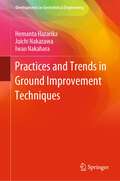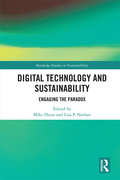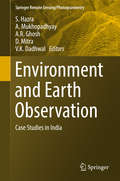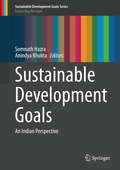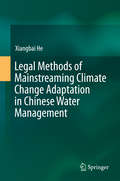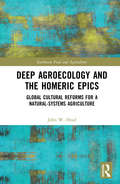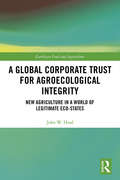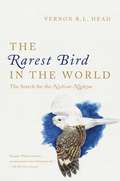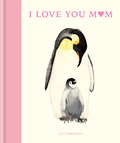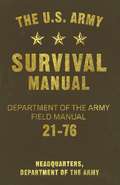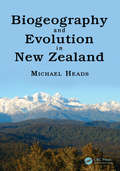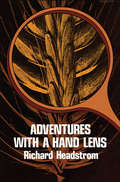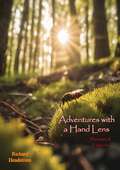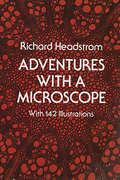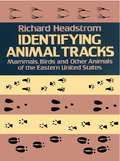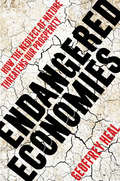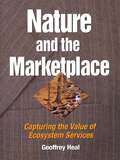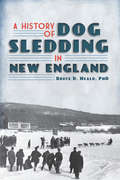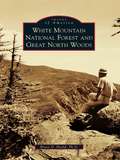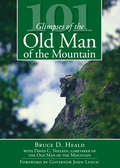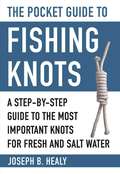- Table View
- List View
Summer Fun
by Carolyn HaywoodA collection of ten stories, five previously published by the author, all of which take place during the summer.
Practices and Trends in Ground Improvement Techniques (Developments in Geotechnical Engineering)
by Hemanta Hazarika Juichi Nakazawa Iwao NakaharaThis book focuses on case studies from Bangladesh, Cambodia, India, Indonesia, Japan, Thailand and the USA in various ground improvement projects. It highlights new applications and trends in ground improvement geo-system including recycling, geo-environmental consideration and preservation of world cultural heritage. The contents will be useful for researchers and engineers to understand how the principles of ground improvement methods are executed in the site, basis of selection of a particular ground improvement technique in a project, cost-benefits of such methods, etc. This volume will also be a useful guide for beginners and intermediate-level practitioners dealing with geotechnical construction projects or who have interest in the development and practical application of ground improvement techniques. Engineers and researchers will find it helpful in developing, advancing and applying their techniques in the field.
Digital Technology and Sustainability: Engaging the Paradox (Routledge Studies in Sustainability)
by Mike Hazas Lisa NathanThis book brings together diverse voices from across the field of sustainable human computer interaction (SHCI) to discuss what it means for digital technology to support sustainability and how humans and technology can work together optimally for a more sustainable future. Contemporary digital technologies are hailed by tech companies, governments and academics as leading-edge solutions to the challenges of environmental sustainability; smarter homes, more persuasive technologies, and a robust Internet of Things hold the promise for creating a greener world. Yet, deployments of interactive technologies for such purposes often lead to a paradox: they algorithmically "optimize" heating and lighting of houses without regard to the dynamics of daily life in the home; they can collect and display data that allow us to reflect on energy and emissions, yet the same information can cause us to raise our expectations for comfort and convenience; they might allow us to share best practice for sustainable living through social networking and online communities, yet these same systems further our participation in consumerism and contribute to an ever-greater volume of electronic waste.By acknowledging these paradoxes, this book represents a significant critical inquiry into digital technology’s longer-term impact on ideals of sustainability. Written by an interdisciplinary team of contributors this book will be of great interest to students and scholars of human computer interaction and environmental studies.
Environment and Earth Observation
by S. Hazra A. Mukhopadhyay A. R. Ghosh D. Mitra V. K. DadhwalThis book presents relevant and contemporary research on the remote sensing of landscapes, agriculture & forestry, geomorphology, coasts & oceans, natural hazards and wild habitats. It highlights the application of remote sensing in understanding natural processes and oceanic features, as well as in creating mapping inventories of water resources across different spatial and temporal scales. Recent advances in hyperspectral imaging and high spatial resolution offer promising techniques for exploring various aspects related to the fruitful and cost-effective monitoring of large-scale environments. In the field of forestry and agriculture, the book addresses topics such as terrain analysis, forest management, updating current forest inventories, and vegetation cover type discrimination. It also elaborates delineation of various geo-morphological features of the earth's surface and natural disasters, and includes a special section on the remote sensing of wild habitats. Readers working in interdisciplinary sectors engaged in remote-sensing-based research benefit from the techniques presented.
Sustainable Development Goals: An Indian Perspective (Sustainable Development Goals Series)
by Somnath Hazra Anindya BhuktaThis volume examines the practicality of achieving the UN Sustainable Development Goals in India, and includes policy analyses and statistical assessments of comparative data between India and different countries. With a focus on poverty and economics, the contributors offer sector and state specific performance analyses of each goal, determining the feasibility for different states and regions to implement a given goal under conditions of extreme poverty and economic distress. Readers will learn how to perform comprehensive economic performance analyses, and how to apply these methods at local and regional scales within the framework of sustainable development. The book will be of interest to students and researchers studying sustainable development, economics, and policy analysis, as well as NGOs and government agencies working towards achieving the SDGs in impoverished nations.
Legal Methods of Mainstreaming Climate Change Adaptation in Chinese Water Management
by Xiangbai HeThis book addresses why, whether and how the existing legal framework on water management in China could make climate change adaptation a mainstream issue. The book uses a table to illustrate the distinctions and similarities between IWRM and water-centered adaptation to analyze the possibilities of mainstreaming adaptation. The new water-planning processes and EIA are also illustrated in the form of figures showing the differences after factoring in adaptation considerations. Interviews with water managers to obtain their perception and attitudes towards climate change adaptation offer new perspectives for readers. The adaptation- mainstreaming approach, which finds a way to balance various interests and tasks, will arouse the interests of those readers who argue that climate change is only one of the issues challenging water management, and that poverty reduction, environmental protection and living standard improvement are even more important. Readers will also be interested to discover that the adaptation mainstreaming approach could be applied in water management institutions such as water planning and EIA. In addition, the book offers a clear explanation of the challenges of adaptation to the existing water-related legal framework from a theoretical perspective, and provides theoretical and practical recommendations.
Deep Agroecology and the Homeric Epics: Global Cultural Reforms for a Natural-Systems Agriculture (Earthscan Food and Agriculture)
by John W. HeadDrawing on the Homeric epics, this multidisciplinary work reveals the cultural transformations which need to take place in order to transition from today’s modern extractive agricultural system to a sustainable natural‐systems agriculture. In order to provide an imaginative foundation on which to build such a cultural transformation, the author draws on the oldest and most pervasive pair of literary works in the Western canon: the Iliad and the Odyssey. He uses themes from those foundational literary works to critique the concept of state sovereignty and to explain how innovative federalism structures around the world already show momentum building toward changes in global environmental governance. The book proposes a dramatic expansion on those innovations, to create eco‐states responsible for agroecological management. Drawing from many years of experience in international institutions, the author proposes a system of coordination by which an international agroecology‐focused organization would simultaneously (i) avoid the shortcomings of the world’s current family of powerful global institutions and (ii) help create and implement a reformed system of local landscape‐based agriculture wholly consistent with ecological principles. Acknowledging the difficulty of achieving reforms such as these, the author suggests that a new cultural‐conceptual narrative can be constructed drawing on values set forth 2,700 years ago in the Homeric epics. He explains how these values can be reimagined to drive forward our efforts in addressing today’s the climate and agricultural crises in ways that reflect, not reject, the natural processes and relationships that make the Earth a living planet. This book will be of great interest to students, academics and policymakers addressing issues of agrarian values, environmental and agricultural law, environmental restoration, agroecology, and global institutional reform.
A Global Corporate Trust for Agroecological Integrity: New Agriculture in a World of Legitimate Eco-states (Earthscan Food and Agriculture)
by John W. HeadThis book examines global environmental governance and how legal, institutional, and conceptual reform can facilitate a transformation to a new ‘natural-systems’ form of agriculture. Profound global climate disruption makes it essential that we replace our current agricultural system – described in this book as a fossil-carbon-dependent ‘modern extractive agriculture’ – with a natural-systems agriculture featuring perennial grains growing in polycultures, thereby mimicking the natural grassland and forest ecosystems that modern extractive agriculture has largely destroyed. After examining relevant international legal and conceptual foundations (sovereignty, federalism, global governance) and existing international organizations focusing on agriculture, the book explores legal and institutional opportunities to facilitate dramatic agricultural reform and ecological restoration. Among other things, it explains how innovative federalism structures around the world provide patterns for reorienting global environmental governance, including what the book calls eco-states that would, through exercise of pluralistic sovereignty, be responsible for agroecological management. Drawing from his experience working in international institutions, the author provides detailed global-governance proposals for facilitating the type of agricultural reform that can help avoid ecological collapse, especially through soil degradation and climate change. This book will be of great interest to students and scholars of international law, agroecology, climate change, ecological restoration, sustainable development, and global governance, as well as policy-makers and practitioners working in these fields.
The Rarest Bird in the World: The Search for the Nechisar Nightjar
by Vernon R HeadPart detective story, part love affair, and pure adventure storytelling at its best, a celebration of the thrill of exploration and the lure of wild places during the search for the elusive Nechisar Nightjar. In 1990, a group of Cambridge scientists arrived at the Plains of Nechisar in Ethiopia. On that expedition, they collected more than two dozen specimens, saw more than three hundred species of birds, and a plethora of rare butterflies, dragonflies, reptiles, mammals, and plants. As they were gathering up their findings, a wing of an unidentified bird was packed into a brown paper bag. It was to become the most famous wing in the world. This wing would set the world of science aflutter. Experts were mystified. The wing was entirely unique. It was like nothing they had ever seem before. Could a new species be named based on just one wing? After much discussion, a new species was announced: Nechisar Nightjar, or Camprimulgus Solala, which means "only wing." And so birdwatchers like Vernon began to dream. Twenty-two years later, he joins an expedition of four to find this rarest bird in the world. In this gem of nature writing, Vernon captivates and enchants as he recounts the searches by spotlight through the Ethiopian plains, and allows the reader to mediate on nature, exploration, our need for wild places, and the human compulsion to name things. Rarest Bird is a celebration of a certain way of seeing the world, and will bring out the explorer in in everyone who reads it.
I Love You Mum
by Abbie HeadonA mother's hug lasts for long after she lets go. There's nowhere warmer or safer than the embrace of a loving mother, and even as we grow older, our thoughts return again and again to the love we received as infants.Just like us, mums from the natural world are devoted to their little ones. From the cuddly walrus who snuggles her cubs tight in her flippers to the brave tiger who defends her precious young from all possible dangers, celebrate the wonder of mum with this little book that reminds us just how special she is.
I Love You Mum
by Abbie HeadonA mother's hug lasts for long after she lets go. There's nowhere warmer or safer than the embrace of a loving mother, and even as we grow older, our thoughts return again and again to the love we received as infants.Just like us, mums from the natural world are devoted to their little ones. From the cuddly walrus who snuggles her cubs tight in her flippers to the brave tiger who defends her precious young from all possible dangers, celebrate the wonder of mum with this little book that reminds us just how special she is.
The U.S. Army Survival Manual
by Headquarters, Department of the ArmyFrom trekking across the desert and bushwhacking through the jungle to conserving body heat in the Arctic and rappelling down a mountain cliff, The U.S. Army Survival Manual presents the field-tested techniques that have proven effective in times of imminent danger and extreme distress.Perfect for Army grunts and weekend outdoorsmen alike, this book teaches the survival skills every camper, hiker and hunter should master before heading into the wild: Erecting shelter Gathering edible plants Fishing, hunting and trapping game Locating and collecting fresh water Starting fires and cooking food Navigating and orientating
Biogeography and Evolution in New Zealand (CRC Biogeography Series #1)
by Michael HeadsBiogeography and Evolution in New Zealand provides the first in-depth treatment of the biogeography of New Zealand, a region that has been a place of long-enduring interest to ecologists, evolutionary scientists, geographers, geologists, and scientists in related disciplines. It serves as a key addition to the contemporary discussion on regionalization—how is New Zealand different from the rest of the world? With what other areas does it share its geology, history, and biota? Do new molecular phylogenies show that New Zealand may be seen as a biological ‘parallel universe’ within global evolution?
Biogeography of Australasia
by Michael HeadsOver the last decade, molecular studies carried out on the Australasian biota have revealed a new world of organic structure that exists from submicroscopic to continental scale. Furthermore, in studies of global biogeography and evolution, DNA sequencing has shown that many large groups, such as flowering plants, passerine birds and squamates, have their basal components in this area. Using examples ranging from kangaroos and platypuses to kiwis and birds of paradise, the book examines the patterns of distribution and evolution of Australasian biodiversity and explains them with reference to tectonic and climatic change in the region. The surprising results from molecular biogeography demonstrate that an understanding of evolution in Australasia is essential for understanding the development of modern life on Earth. A milestone in the literature on this subject, this book will be a valuable source of reference for students and researchers in biogeography, biodiversity, ecology and conservation.
Adventures with a Hand Lens
by Richard HeadstromWith an ordinary magnifying glass and this book as your guide, 50 adventures in close observation await you. These entertaining nature studies take you on field trips in and around your home, calling attention to interesting features of dozens of familiar or overlooked plants, insects, and other animals, and common materials like cloth, quartz, and the paper on which this book is printed.A great deal of basic natural-science theory and detail is presented in this delightful narrative. Flowers and grasses, fish scales, moth and insect wings, egg cases, buds, feathers, seeds, leaf scars, moss, molds, ferns, and common crystals are among the many structures examined, often comparatively. Many natural processes and behavior patterns are observed -- seed dispersal and other methods of reproduction, protective coloration, rusting symbiosis, fertilization of the soil, breathing and case building of insects, and many others, all with only an inexpensive hand lens as equipment and with "specimens" you probably pass by going for a walk. More than 200 labeled illustrations accompany the text.The author is a former teacher and associate curator of the New England Museum of Natural History. No previous science background is assumed of readers, and curious readers of almost any age will find this book an interesting introduction to numerous facets of nature study.
Adventures with a Hand Lens [Illustrated Edition]
by Richard HeadstromIncludes over 200 illustrations by the author.Here are fifty adventures that any of us could have. The only equipment needed is a hand lens and an inquiring mind. At home, in the woods, fields, ponds and along the roadside are familiar things that under the glass show us exciting and sometimes beautiful details that we could not see without this help.Have you ever looked at the antennae of an ant under a lens, or seen the bristles on an earthworm? Did you know that a certain moss has a capsule that looks like a pepper box? A piece of granite seen through a glass shows us that it is made up of various crystals. These are the kinds of things that an adventurer with a hand lens can discover. Not only has the author described these experiments in lively and clear text but he has illustrated them with over two hundred line drawings.
Adventures with a Microscope
by Richard HeadstromWith a simple microscope and this book, you can embark on 59 wonderful adventures in the natural world -- make discoveries about the structures of numerous microscopic animals; find out what everyday objects and foods really look like at the cellular level; gain an understanding of how to prepare specimens and slides; and learn about many scientific phenomena such as how a fly can walk upside down on the ceiling. It's all here in simple-to-understand language and 142 clear line drawings.The author first examines under the microscope such everyday objects as a human hair, air bubble, scale of a herring, poppy seed and sugar crystal, and then offers through-the-microscope views of such creatures and objects as the water flea, hydra, house fly, amoeba, euglena, volvox, diatoms, desmids, algae, blood corpuscles, honey bee, rotifer, water-mites, potato starch, and other food substances, lichen, paramecium, coffee, sponge, chalk, yeast, bacteria, mustard, pepper, bryozoan, moss, mushroom, molds, cotton, and other textile fibers, ferns, dragon-flies, flea, spider, roots, and other plant structures, paper, aphid, fingerprints, nervous system of the grasshopper, and more.Richard Headstrom, formerly associated with the New England Museum of Natural History and an experienced teacher and writer on natural science for young people, has made this book simple enough for any beginner at home as well as interesting for more experienced students and lay readers. Enjoyable and instructive, these adventures with a microscope will appeal to all who are curious about what there is to see beyond the range of the naked eye.
Identifying Animal Tracks: Mammals, Birds, and Other Animals of the Eastern United States
by Richard HeadstromFor hunters, naturalists, scouts, nature lovers. How to recognize tracks of alligators, bobcats, centipedes, owls, skunks, toads, and many other animals. Diagrams of tracks, tips on identification. "...interesting and a good inexpensive introduction..." -- The Naturalist (UK).
Endangered Economies: How the Neglect of Nature Threatens Our Prosperity
by Geoffrey HealIn the decades since Geoffrey Heal began his field-defining work in environmental economics, one central question has animated his research: "Can we save our environment and grow our economy?" This issue has become only more urgent in recent years with the threat of climate change, the accelerating loss of ecosystems, and the rapid industrialization of the developing world. Reflecting on a lifetime of experience not only as a leading voice in the field, but as a green entrepreneur, activist, and advisor to governments and global organizations, Heal clearly and passionately demonstrates that the only way to achieve long-term economic growth is to protect our environment. Writing both to those conversant in economics and to those encountering these ideas for the first time, Heal begins with familiar concepts, like the tragedy of the commons and unregulated pollution, to demonstrate the underlying tensions that have compromised our planet, damaging and in many cases devastating our natural world. Such destruction has dire consequences not only for us and the environment but also for businesses, which often vastly underestimate their reliance on unpriced natural benefits like pollination, the water cycle, marine and forest ecosystems, and more. After painting a stark and unsettling picture of our current quandary, Heal outlines simple solutions that have already proven effective in conserving nature and boosting economic growth. In order to ensure a prosperous future for humanity, we must understand how environment and economy interact and how they can work in harmony—lest we permanently harm both.
Nature and the Marketplace: Capturing The Value Of Ecosystem Services
by Geoffrey HealIn recent years, scientists have begun to focus on the idea that healthy, functioning ecosystems provide essential services to human populations, ranging from water purification to food and medicine to climate regulation. Lacking a healthy environment, these services would have to be provided through mechanical means, at a tremendous economic and social cost.Nature and the Marketplace examines the controversial proposition that markets should be designed to capture the value of those services. Written by an economist with a background in business, it evaluates the real prospects for various of nature's marketable services to "turn profits" at levels that exceed the profits expected from alternative, ecologically destructive, business activities. The author: describes the infrastructure that natural systems provide, how we depend on it, and how we are affecting it explains the market mechanism and how it can lead to more efficient resource use looks at key economic activities -- such as ecotourism, bioprospecting, and carbon sequestration -- where market forces can provide incentives for conservation examines policy options other than the market, such as pollution credits and mitigation banking considers the issue of sustainability and equity between generations .Nature and the Marketplace presents an accessible introduction to the concept of ecosystem services and the economics of the environment. It offers a clear assessment of how market approaches can be used to protect the environment, and illustrates that with a number of cases in which the value of ecosystems has actually been captured by markets.The book offers a straightforward business economic analysis of conservation issues, eschewing romantic notions about ecosystem preservation in favor of real-world economic solutions. It will be an eye-opening work for professionals, students, and scholars in conservation biology, ecology, environmental economics, environmental policy, and related fields.
A History of Dog Sledding in New England (Sports)
by Bruce D. HealdSled dogs trot through expanses of sparkling white snow, pulling a musher and energetically surging with the command, "Let's go!" From puppies to seasoned competitors, sled dogs partner with mushers in a passionate pursuit of a great racing tradition. The renowned and formidable Laconia World Championship Sled Dog Derby, the New England Sled Dog Club and famous drivers like Dr. Charles Belford--who came in fifth place at Laconia at the age of seventeen--helped solidify the fame of New England sled dog trails. Historian Bruce D. Heald celebrates the best of the sport in the region, from the feats of legendary Arthur Walden and his famous Chinook dogs to the Siberian huskies' contribution to the World War II effort. Join Heald as he charts the legacy of this remarkable sport.
White Mountain National Forest and Great North Woods
by Bruce D. HealdThe White Mountain National Forest and Great North Woods have been described as "nature's mammoth museum." This is a land of many lakes and rivers, mountains and waterfalls, and pristine natural splendor, abundant with historic charm. The White Mountain National Forest was established by presidential proclamation in 1918. It owes its existence to the passage of the Weeks Act of 1911, which enabled the federal government to purchase land and establish a national forest in New Hampshire's White Mountains. It is one of the most visited natural sites in the country, and tourists from all over the world make seasonal visits to this recreational haven. This book takes the reader on a historical journey through the national forest, including the majesty and grandeur of the Presidential Range, Great Gulf Wilderness, Pemigewasset Wilderness, and Sandwich Range Wilderness, as well as Franconia Notch, Pinkham Notch, Crawford Notch, and Great North Woods.
101 Glimpses of the Old Man of the Mountain
by Bruce D. Heald David C. Nielsen Governor John LynchThe Old Man of the Mountain once cast a steady gaze upon the slopes of Franconia Notch. Its profile drew writers, explorers and presidents, delighting all who glimpsed its features. But when it collapsed on May 3, 2003, the Old Man seemed forever lost. Veteran historian Bruce Heald and the last caretaker of the Old Man, David Nielsen, have gathered 101 images from the profile's long history. These one-of-a-kind photos from Nielsen's private collection depict four decades of preservation work, seismic testing by national experts, visits from dignitaries and rare memorabilia. With Nielsen's personal reflections on his life's work and Heald's notes on the history of the Old Man, this volume recaptures the wonder of New Hampshire's great stone face.
600 Decorative Floral Designs (Dover Pictorial Archive)
by F. B. HealdThe Victorians loved their flowers, and from a stunning nineteenth-century collection of floral motifs comes this garden of decorative designs. Exquisitely detailed and stylistically rare, its illustrations feature lush blossoms and plants surrounded by design elements of the most magnificent order.These 72 pages offer a wealth of images for a virtually unlimited array of applications. Perfect for enhancing greeting cards, newsletters, and websites, these gorgeous black-and-white patterns also offer inspiration for needlework and other craft projects.
The Pocket Guide to Fishing Knots: A Step-by-Step Guide to the Most Important Knots for Fresh and Salt Water (Skyhorse Pocket Guides)
by Joseph B. HealyAnyone who has spent time on the water knows that fishing success comes down to effective connections—the angler must first ensure that the knot connections throughout the fishing line are sound and appropriate for the task at hand. A failed knot—picture a wind knot tarpon leader made a huge silver king pulls hit a fly or a seven-pound bass pulls free because of a poorly tied attachment to your crankbait—will bring your otherwise happy day to a screeching halt and leave you muttering about what might have been. In The Pocket Guide to Fishing Knots, learn the knots of success, and why the connections are recommended by the country's top anglers. Some of the knots featured here include:Blood knotPerfection loopImproved clinch Double surgeon's Albright knot Whether you’ve spent a lifetime fishing the waters of the world, or this is your first season casting a line, The Pocket Guide to Fishing Knots will be sure to help you get your biggest catch yet.

